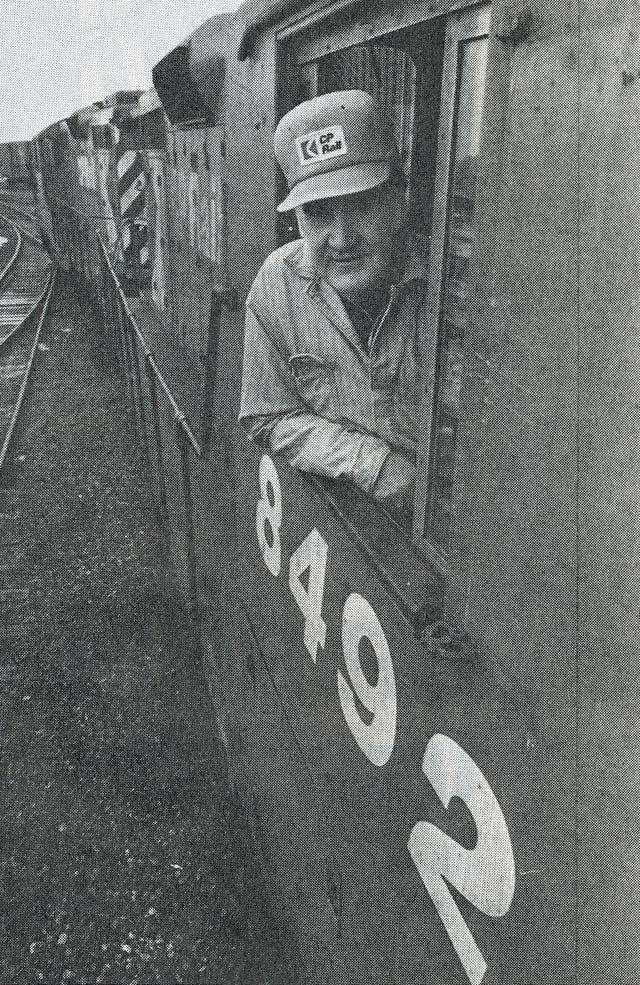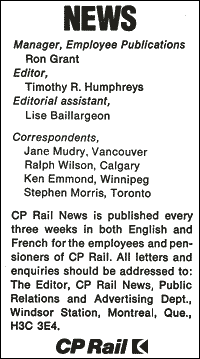
1982-1984


"It's more like driving a car"
Brandon Manitoba - The romance of the railways may be based on the steam locomotive, but CP Rail Locomotive Engineer Bill Mummery is quite content to operate a diesel.
"With a steam engine you have to watch your steam pressure and your water glass monitoring the water level in the boiler, and just see that everything's going well," said Mr. Mummery. "With a diesel you get different gauges, it's more like running a car."
Mr. Mummery said the operation of pulling a train is much the same, however, since the air brakes and the other controls have not changed much in recent years.
It's the simplicity of the diesel engine that makes it nice, with better traction from the heavier units and the worry of firing the engine eliminated.
"It's a lot cleaner," he said. "There isn't the hard work that went along with the steam."
The cabs are better insulated from the elements these days, too. In the days of the coal-fired engines, said Mr. Mummery, "you'd be roasting on one side and freezing on the other in the winter time."
The railway has been Mr. Mummery's life for 40 years, he started helping to service engines between runs as a summer employee back in 1943 when he was a youth of 15.
Railroading is also a family tradition, his father was a locomotive engineer, his grandfather was a boilermaker, and his cousin Wes is the railway's chief mechanical officer.
When Mr. Mummery got his locomotive engineer's papers in 1951 the railway operated exclusively on steam. He "wrote up" for a locomotive engineer after spending seven years as a fireman, firing the steam boiler and watching the locomotive engineer do his work.
The change-over to diesels began in the late 1950s and within 10 years the railway had converted completely to diesel power.
Working out of Brandon, Mr. Mummery operates on the 131-mile (211-kilometre) run west to Broadview, Saskatchewan.
He is slated to run a train whenever his name surfaces at the top of a list of about 10 locomotive engineers.
"Usually it's 30 to 36 hours between runs in the middle of the week," Mr. Mummery said. "On the weekends it's usually 24 to 30 hours that you're home."
He is telephoned at home, at any time of day or night, when it's his turn to go.
"They say you're married to the phone half the time," he said, adding "actually, we have quite a bit of time off."
The size and nature of the train, weather, and the amount of other traffic combine to determine the time it takes to get to Broadview.
 "You never know whether you're going to be five hours or 10 hours on the road," said Mr. Mummery. Once at Broadview, he usually cooks a
meal, watches television, or takes a nap at a CP Rail bunkhouse while awaiting an eastbound train to run back to Brandon.
"You never know whether you're going to be five hours or 10 hours on the road," said Mr. Mummery. Once at Broadview, he usually cooks a
meal, watches television, or takes a nap at a CP Rail bunkhouse while awaiting an eastbound train to run back to Brandon.
Mr. Mummery knows every curve, every rise, and every bump on the Brandon-to-Broadview road, and maintains that this is the way it should be for safe operation of a train.
"The big thing is knowing the road, where you're at," he said. "If you're going over a strange sub-division you ask for a pilot."
The operations are pretty standard, no matter what the cargo is, so the biggest uncertainties usually come from cars and trucks at highway crossings.
"The risks some people take at a crossing!" said Mr. Mummery. "It sure gives you a sick feeling in the pit of your stomach."